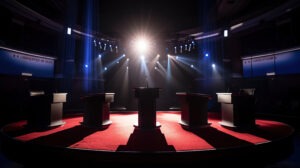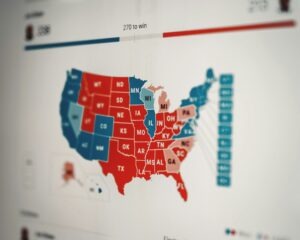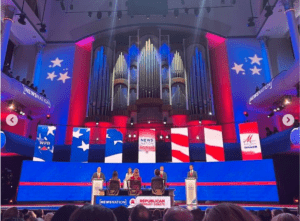The Super Bowl of Persuasion
Published on December 23, 2023, 12:41 p.m.
by Ali Burleson.
Over 63 years ago, many Americans gathered around the television screen to narrow their focus on the first televised presidential debate. Since then, communication strategies have evolved. Yet, at the heart of these debates, the purpose remains the same. A presidential debate is deemed effective when the candidate thoroughly persuades, informs and engages voters.
Debate effectiveness

More times than not, the first general debate is the most anticipated of the election cycle and, ultimately, draws the most viewers. According to Nielsen, the first general debate of 2016 acquired 84 million people in viewership. During the 2020 election cycle, 73 million people tuned in to watch the first Trump-Biden debate.
The debates are often televised by an overwhelming number of networks. This past election cycle was televised by 16 different networks. Though these numbers do showcase a massive amount of viewership, they do not document the entirety of the media landscape. “An unknown number of people live-streamed the debate on various devices, listened on the radio, or watched in other ways,” CNN reported.
The only televised program to surpass debate viewership is the annual NFL Super Bowl, gaining over 112 million views. That representation in itself demonstrates the severity of how crucial televised debates are to the people of the United States.
Advantages of televised debates
Josh Bramlett, assistant professor in the Department of Advertising and Public Relations at The University of Alabama and avid consumer of politics, weighed in on the significant hold presidential debates have in our country.
“For all of the flaws of presidential debates, from candidates interrupting each other to funny, distracting moments, debates are still the best condensed moments for voters to learn about candidates on a variety of fronts,” said Bramlett. “In debates, we don’t just learn about where candidates stand on policy, but we learn who [the candidates] are as people in an uncontrolled manner.”
Merriam-Webster reported that one of the most searched words of the year was “authentic,” and with the rise of the digital age, it becomes increasingly harder to uncover authenticity in a presidential candidate. However, voters are still looking for a candidate characterized as authentic and reliable to hold office.
Debates, though intricate, display the raw, authentic version of a nominee. Bramlett discovered in his dissertation research that debates “activate [viewers’] interest in a campaign.” The activation of interest leads to viewers conducting their own research through mainstream media and digital media. Therefore, interest alone can lead to advocacy for a candidate.
Challenges of debates
Debates remain the primary campaign strategy for candidates to persuade, inform and engage voters. However, the strategy isn’t without its challenges. Abhi Rahman, national communications director for the Democratic Legislative Campaign Committee, revealed a significant challenge in the debate atmosphere that professionals are struggling to conquer. “With multimedia platforms, people are tuning into debates less than in the past. These are challenges we have to overcome,” Rahman said.

Practitioners across various industries are finding it hard to connect with audiences due to the fragmented media landscape. Individuals are constantly bombarded with various sources seeking their attention.
According to Marketing Week, consumers are now inundated with options due to the dominance of social media platforms. How can candidates effectively capture and maintain the audience’s attention in the realm of debates amidst media saturation?
Amelia Joy, current press secretary for the governor of South Dakota and former employee of the Republican National Committee, believes the answer lies within the candidates.
“When speaking to an audience, you are typically working with about a 10-second attention span. That means that every 10 seconds, you need to be sure to say something to regain your audience’s attention,” Joy stated.
“The mistake that many candidates make is that they can talk for hours about what they think, but they never get to why they think the way they do,” Joy said. “If [candidates] can’t get people to agree with [their] why, [they’re] never going to be successful.”
In an article addressing the challenge of navigating the fragmented media landscape to harness consumer attention, Caroline Orange-Northey of Amazon Ads remarked, “When people feel seen and heard, that’s when they reciprocally pay attention.”
Nonverbal communication importance
Joy holds her Master of Arts in political communications, and her expansive knowledge and research in the history of nonverbal communication within the confines of presidential debates capitalized on the transformation of communication strategies. “The primary trend that emerged is that voters view conventionally pleasant and positive nonverbal cues as a plus. This includes things like warm smiles, good posture, relaxed hand gestures and confident eye contact,” Joy said.
In a separate study, Joy’s research shed light on the influence of nonverbal communication on the decisions of uneducated voters. “Nonverbal communication plays a huge role in this, as well. When a voter doesn’t really understand the argument that a candidate is making, they will make the decision on who to vote for based solely on nonverbal cues,” Joy said. She emphasized that nonverbal communication can “either make or break a candidate.”
Reflecting on the 1960 election cycle featuring Richard Nixon and John F. Kennedy, Joy highlighted a notable example. During that era, radio listeners perceived Nixon as the clear winner, while television viewers favored Kennedy. The disparity in perception underscores the importance of nonverbal communication.
The example serves as a pillar in thoroughly understanding the differences in communication nuances. “Simple things like making eye contact with both the audience present at the debate and the camera, standing with proper posture, and wearing a suit that is well-tailored can go a long way in creating the ‘presidential, yet approachable’ look,” Joy stated.
Media literacy within the political sphere
Media literacy is defined by Oxford Languages as “the ability to critically analyze stories presented in the mass media and to determine their accuracy or credibility.” As channels of media expand, it’s vital for voters to ensure the information disseminated from candidates is accurate and reliable.

“Media literacy is the most important thing for voters to make an informed decision. Knowing what’s real and what isn’t is crucial, and that’s why voters need to be informed,” Rahman said.
Not only is education on media literacy a crucial aspect for voters, but it is equally as important for candidates.
“In terms of candidates, knowing how to navigate the media and get a message out is crucial. That’s something we strive to teach them, and we strive to ensure they are always doing,” Rahman stated.
Bramlett noted that “having concise and understandable messaging” serves as a way for these presidential candidates to relay their messages and engage audiences.
Across party lines, there is a consensus on the significance of understanding and utilizing different forms of media. “I firmly believe that it is the job of the candidate to meet the voters where they’re at, not to make the voters come to them,” Joy said. “If you understand how you can use different forms of media to your advantage, you can place ads and messaging in the perfect place to secure the votes you need.”
As the national communications director for the Democratic Legislative Campaign Committee, Rahman is responsible for coordinating communications, including internal messaging, external messaging and media relations, while ensuring that the Committee is “put in the best light possible at all times.”
Rahman gave insight into how the Democratic Party prioritizes media literacy for candidates participating in televised debates. “A debate is often the best opportunity for a candidate to make their mark, and we ensure that we have debate coaches, debate guides and a lot of mock debate time,” Rahman said.
Relevance to PR practitioners
“There are a lot of logistics that go into debates as events,” said Bramlett. “Debates are the ultimate event to organize where it has to be perfectly executed. Having communication and public relations professionals helps for something to go off without a hitch.”
Rahman emphasized the various, intricate aspects that practitioners are involved in when preparing for a presidential debate. “It is crucial that communications and public relations specialists are controlling every aspect for candidates,” said Rahman. Practitioners are controlling everything “from what [candidates are] wearing, what they’re saying, what breaks there are [to] format … and messaging to reporters during the debate itself.”
Speaking on behalf of the Democratic Legislative Campaign Committee, Rahman said there is also a level of communication with media organizations during a debate to maximize the reach and impact. “We are pushing out messaging for our candidate, against other candidates, and through pre-debate and post-debate spin,” Rahman said. These efforts put forth by practitioners allow the candidate to receive positive narratives and put them in a strong position leading up to election day.
“There are so many elements of negotiating and planning that go into debates to ensure the success of a debate,” said Bramlett.
With a multitude of small, yet vital, aspects of a presidential debate, communication and public relations practitioners are at the forefront of its success. Practitioners play a key role in details such as advising candidates before a debate to controlling the way a narrative is spun in the media after the debate. With the prevalence of unpredictable and uneducated voters, the responsibility falls upon the practitioners and their team to ensure voters are actively persuaded, informed and engaged.




